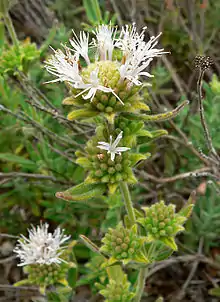| Monardella | |
|---|---|
 | |
| Monardella hypoleuca ssp. lanata | |
| Scientific classification | |
| Kingdom: | Plantae |
| Clade: | Tracheophytes |
| Clade: | Angiosperms |
| Clade: | Eudicots |
| Clade: | Asterids |
| Order: | Lamiales |
| Family: | Lamiaceae |
| Tribe: | Mentheae |
| Genus: | Monardella L. |
| Species | |
| Synonyms[1] | |
| |
Monardella is a genus of approximately 40 species of annual and perennial plants native to western North America from British Columbia to northwestern Mexico.[1][3][4] They are grown for their highly aromatic foliage, which in some species is used for herbal teas. The two-lipped, tubular flowers are formed in terminal clusters and are most usually red, pink, or purple.[5]
Monardella is a Latin diminutive form of Monarda (a taxonomic patronym honoring the Spanish botanist Nicolás Monardes), which the form of the flower heads resembles. [2] Plants in this genus are commonly known as wildmints, coyote mints or monardellas.
Systematics
The genus comprises the following species.[1]
- Monardella antonina Hardham - California
- Monardella arizonica Epling - Arizona
- Monardella australis Abrams - southern California
- Monardella beneolens Shevock, Ertter & Jokerst - southern California
- Monardella boydii A.C.Sanders & Elvin - southern California
- Monardella breweri A.Gray - California, Nevada, Arizona, Baja California
- Monardella candicans Benth. - San Joaquín Valley of California
- Monardella douglasii Benth. - San Francisco Bay area of California
- Monardella eplingii Elvin et al.[6] - Arizona
- Monardella eremicola A.C.Sanders & Elvin - southern California
- Monardella exilis (A.Gray) Greene - southern California, Arizona
- Monardella follettii (Jeps.) Jokerst - northern Sierra Nevada in California
- Monardella frutescens (Hoover) Jokerst - California
- Monardella hypoleuca A.Gray - southern California, Baja California
- Monardella lagunensis M.E.Jones - Baja California Sur
- Monardella lanceolata A.Gray - California
- †Monardella leucocephala A.Gray - Merced & Stanislaus counties in California but believed to be extinct
- Monardella linoides A.Gray - California, Arizona, Nevada, Baja California
- Monardella macrantha A.Gray - California, Baja California
- Monardella mojavensis Elvin & A.C.Sanders - Mohave Desert of southeastern California & southern Nevada
- Monardella nana A.Gray - California, Baja California
- Monardella odoratissima Benth. - mountain wildmint, mountain coyote mint or mountain pennyroyal - much of western North America from British Columbia south to southern California & New Mexico
- Monardella palmeri A.Gray - Santa Lucia Mountains of west-central California
- †Monardella pringlei A.Gray - Mohave Desert of southeastern California but believed to be extinct
- Monardella purpurea Howell - Oregon, California
- Monardella robisonii Epling ex Munz - Mohave Desert of southeastern California
- Monardella saxicola I.M.Johnst. - southeastern California
- Monardella sheltonii Torr. ex Durand - Oregon, California
- Monardella sinuata Elvin & A.C.Sanders - coastal central California
- Monardella siskiyouensis Hardham - northern California
- Monardella stebbinsii Hardham & Bartel - Plumas County in northern California
- Monardella stoneana Elvin & A.C.Sanders - San Diego County in California, Baja California
- Monardella × subglabra (Hoover) Hardham - California (M. purpurea × M. villosa)
- Monardella thymifolia Greene - Cedros Island in Baja California
- Monardella undulata Benth. - coastal central California
- Monardella venosa (Torr.) A.C.Sanders & Elvin - central California
- Monardella villosa Benth. - (common) coyote mint - Oregon, California
- Monardella viminea Greene - San Diego County in southern California
- Monardella viridis Jeps. - northern San Francisco Bay area of California (Sonoma, Napa, Solano, & Lake Counties)
Horticulture and ecology
Most like a sunny, sharply drained site and can be attractive in a rock garden or pot in the alpine house if smaller species are selected. The taller ones can be used at the front of a dry sunny border. They have reasonable frost resistance, but resent dampness in winter. Propagate from seed or summer cuttings of perennial species, or by division of clumps.
Monardella is a nectar plant for many Lepidoptera (butterflies and moths), including the endangered Myrtle's silverspot (Speyeria zerene myrtleae).
Several species are rare California endemics; two, the Merced monardella (M. leucocephala) and Pringle's monardella (M. pringlei), have not been seen in many decades and are presumed extinct.[7][8]
Notes
- ↑ Madronella is a taxonomic anagram of Monardella.[2]
References
- 1 2 3 Kew World Checklist of Selected Plant Families
- 1 2 Burkhardt, Lotte (2018-06-06). Verzeichnis eponymischer Pflanzennamen - Erweiterte Edition. Index of Eponymic Plant Names - Extended Edition. Index de Noms éponymiques des Plantes - Édition augmentée (in German). Botanic Garden and Botanical Museum Berlin, Freie Universität Berlin. p. M64. doi:10.3372/epolist2018. ISBN 978-3-946292-26-5. S2CID 187926901.
- ↑ Biota of North America Program 2013 county distribution maps
- ↑ Elvin, M.A. & Sanders, A.C. (2009). Nomenclatural changes for Monardella (Lamiaceae) in California. Novon 19: 315-343.
- ↑ Jepson Manual Treatment
- ↑ Elvin, M. A., et al. (2013). Monardella eplingii, a new species from the Black Mountains of northwestern Arizona, USA. Madroño 60(1) 46-54.
- ↑ Jepson Manual Treatment: M. leucocephala
- ↑ Jepson Manual Treatment: M. pringlei